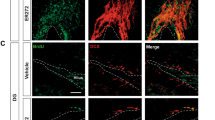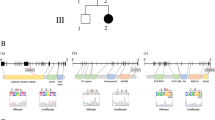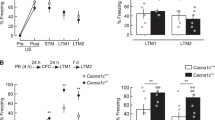Abstract
Aim:
The aim of this study was to investigate the cognition-enhancing activity and underlying mechanisms of a triterpenoid saponin (polygalasaponin XXXII, PGS32) isolated from the roots of Polygala tenuifolia Willd.
Methods:
The Morris water maze was used to evaluate the spatial learning and memory of mice. To detect the basic properties of synaptic transmission and long-term potentiation (LTP) in the dentate gyrus of rats, electrophysiological recordings were made of evoked potentials. Western blotting analysis and immunofluorescence assays were used to determine the phosphorylation of extracellular signal-regulated kinase (ERK), cAMP response element-binding protein (CREB), synapsin I and the expression of brain derived neurotrophic factor (BDNF).
Results:
When administered at 0.125, 0.5, or 2 mg/kg, PGS32 could significantly prevent scopolamine-induced cognitive impairments in mice. Intracerebroventricular (icv) administration of PGS32 greatly enhanced basic synaptic transmission in the dentate gyrus of rats and induced LTP. In primary hippocampal neurons, as well as in the hippocampus of maze-trained mice, PGS32 activated the mitogen-activated protein (MAP) kinase cascade by promoting phosphorylation of ERK, CREB and synapsin I. The expression of BDNF was also greatly enhanced in the hippocampus.
Conclusion:
Our findings suggest that PGS32 can improve hippocampus-dependent learning and memory, possibly through improvement of synaptic transmission, activation of the MAP kinase cascade and enhancement of the level of BDNF. Therefore, PGS32 shows promise as a potential cognition-enhancing therapeutic drug.
Similar content being viewed by others
Log in or create a free account to read this content
Gain free access to this article, as well as selected content from this journal and more on nature.com
or
References
Sakata Y, Chida R, Ishige K, Edagawa Y, Tadano T, Ito Y . Effect of a nutritive-tonic drink on scopolamine-induced memory impairment in mice. Biol Pharm Bull 2005; 28: 1886–91.
Sun XL, Ito H, Masuoka T, Kamei C, Hatano T . Effect of Polygala tenuifolia root extract on scopolamine-induced impairment of rat spatial cognition in an eight-arm radial maze task. Biol Pharm Bull 2007; 30: 1727–31.
Joshi H, Parle M . Brahmi rasayana improves learning and memory in mice. Evid Based Complement Alternat Med 2006; 3: 79–85.
Park CH, Choi SH, Koo JW, Seo JH, Kim HS, Jeong SJ, et al. Novel cognitive improving and neuroprotective activities of Polygala tenuifolia Willdenow extract, BT-11. J Neurosci Res 2002; 70: 484–92.
Ikeya Y, Takeda S, Tunakawa M, Karakida H, Toda K, Yamaguchi T, et al. Cognitive improving and cerebral protective effects of acylated oligosaccharides in Polygala tenuifolia. Biol Pharm Bull 2004; 27: 1081–5.
Naito R, Tohda C . Characterization of anti-neurodegenerative effects of Polygala tenuifolia in Abeta(25-35)-treated cortical neurons. Biol Pharm Bull 2006; 29: 1892–6.
Zhang D, Miyase T, Kuroyanagi M, Umehara K, Ueno A . Five new triterpene saponins, polygalasaponins XXVIII-XXXII from the root of Polygala japonica Houtt. Chem Pharm Bull (Tokyo) 1996; 44: 810–5.
Tyler WJ, Alonso M, Bramham CR, Pozzo-Miller LD . From acquisition to consolidation: on the role of brain-derived neurotrophic factor signaling in hippocampal-dependent learning. Learn Mem 2002; 9: 224–37.
Bliss TV, Gardner-Medwin AR . Long-lasting potentiation of synaptic transmission in the dentate area of the unanaestetized rabbit following stimulation of the perforant path. J Physiol 1973; 232: 357–74.
Bliss TV, Lomo T . Long-lasting potentiation of synaptic transmission in the dentate area of the anaesthetized rabbit following stimulation of the perforant path. J Physiol 1973; 232: 331–56.
Bliss TV, Collingridge GL . A synaptic model of memory: long-term potentiation in the hippocampus. Nature 1993; 361: 31–9.
Chang L, Karin M . Mammalian MAP kinase signalling cascades. Nature 2001; 410 (6824): 37–40.
Pearson G, Robinson F, Beers GT, Xu BE, Karandikar M, Berman K, et al. Mitogen-activated protein (MAP) kinase pathways: regulation and physiological functions. Endocr Rev 2001; 22: 153–83.
Selcher JC, Atkins CM, Trzaskos JM, Paylor R, Sweatt JD . A necessity for MAP kinase activation in mammalian spatial learning. Learn Mem 1999; 6: 478–90.
Blum S, Moore AN, Adams F, Dash PK . A mitogen-activated protein kinase cascade in the CA1/CA2 subfield of the dorsal hippocampus is essential for long-term spatial memory. J Neurosci 1999; 19: 3535–44.
Miller CA, Marshall JF . Molecular substrates for retrieval and reconsolidation of cocaine-associated contextual memory. Neuron 2005; 47: 873–84.
Tapia-Arancibia L, Aliaga E, Silhol M, Arancibia S . New insights into brain BDNF function in normal aging and Alzheimer disease. Brain Res Rev 2008; 59: 201–20.
Li C, Yang J, Yu S, Chen N, Xue W, Hu J, et al. Triterpenoid saponins with neuroprotective effects from the roots of Polygala tenuifolia. Planta Med 2008; 74: 133–41.
Liu SL, Zhang JT . Effects of naloxone on L-clausenamide-induced long-term potentiation in dentate gyrus of anesthetized rats. Zhongguo Yao Li Xue Bao 1999; 20: 112–6.
Wang XY, Zhang JT . NO mediates ginsenoside Rg1-induced long-term potentiation in anesthetized rats. Acta Pharmacol Sin 2001; 22: 1099–102.
Bouger PC, van der Staay FJ . Rats with scopolamine- or MK-801-induced spatial discrimination deficits in the cone field task: animal models for impaired spatial orientation performance. Eur Neuropsychopharmacol 2005; 15: 331–46.
Wang R, Yan H, Tang XC . Progress in studies of huperzine A, a natural cholinesterase inhibitor from Chinese herbal medicine. Acta Pharmacol Sin 2006; 27: 1–26.
Richter-Levin G, Canevari L, Bliss TV . Long-term potentiation and glutamate release in the dentate gyrus: links to spatial learning. Behav Brain Res 1995; 66: 37–40.
Martin SJ, Grimwood PD, Morris RG . Synaptic plasticity and memory: an evaluation of the hypothesis. Annu Rev Neurosci 2000; 23: 649–711.
Shalin SC, Hernandez CM, Dougherty MK, Morrison DK, Sweatt JD . Kinase suppressor of Ras1 compartmentalizes hippocampal signal transduction and subserves synaptic plasticity and memory formation. Neuron 2006; 50: 765–79.
Kelleher RJ III, Govindarajan A, Jung HY, Kang H, Tonegawa S . Translational control by MAPK signaling in long-term synaptic plasticity and memory. Cell 2004; 116: 467–79.
Sweatt JD . The neuronal MAP kinase cascade: a biochemical signal integration system subserving synaptic plasticity and memory. J Neurochem 2001; 76: 1–10.
Carew TJ . Molecular enhancement of memory formation. Neuron 2008; 16: 5–8.
Pang PT, Lu B . Regulation of late-phase LTP and long-term memory in normal and aging hippocampus: role of secreted proteins tPA and BDNF. Ageing Res Rev 2004; 3: 407–30.
Tully T, Bourtchouladze R, Scott R, Tallman J . Targeting the CREB pathway for memory enhancers. Nat Rev Drug Discov 2003; 2: 267–77.
Fumagalli F, Racagni G, Riva MA . The expanding role of BDNF: a therapeutic target for Alzheimer's disease? Pharmacogenomics J 2006; 6: 8–15.
da Penha BM, Cooper J, Castren E, Zafra F, Sofroniew M, Thoenen H, et al. Cholinergic regulation of brain-derived neurotrophic factor (BDNF) and nerve growth factor (NGF) but not neurotrophin-3 (NT-3) mRNA levels in the developing rat hippocampus. J Neurosci 1993; 13: 3818–26.
Lindefors N, Ernfors P, Falkenberg T, Persson H . Septal cholinergic afferents regulate expression of brain-derived neurotrophic factor and beta-nerve growth factor mRNA in rat hippocampus. Exp Brain Res 1992; 88: 78–90.
Tao X, Finkbeiner S, Arnold DB, Shaywitz AJ, Greenberg ME . Ca2+ influx regulates BDNF transcription by a CREB family transcription factor-dependent mechanism. Neuron 1998; 20: 709–26.
Jovanovic JN, Benfenati F, Siow YL, Sihra TS, Sanghera JS, Pelech SL, et al. Neurotrophins stimulate phosphorylation of synapsin I by MAP kinase and regulate synapsin I-actin interactions. Proc Natl Acad Sci USA 1996; 93: 3679–83.
Acknowledgements
This work was supported in part by grants from Naitonal Natural Science Foundation of China (No 30572342), the Program for Changjiang Scholars and Innovative Research Team in University (PCSIRT No IRT0514), and the basic R&D Project for Central public research institutes-Youth Fund (2007CHX04).
Author information
Authors and Affiliations
Corresponding author
Rights and permissions
About this article
Cite this article
Xue, W., Hu, Jf., Yuan, Yh. et al. Polygalasaponin XXXII from Polygala tenuifolia root improves hippocampal-dependent learning and memory. Acta Pharmacol Sin 30, 1211–1219 (2009). https://doi.org/10.1038/aps.2009.112
Received:
Accepted:
Published:
Issue date:
DOI: https://doi.org/10.1038/aps.2009.112
Keywords
This article is cited by
-
Low corticosterone levels attenuate late life depression and enhance glutamatergic neurotransmission in female rats
Acta Pharmacologica Sinica (2021)
-
Targeting Inflammatory Pathways in Alzheimer’s Disease: A Focus on Natural Products and Phytomedicines
CNS Drugs (2019)
-
Polygalasaponin XXXII, a triterpenoid saponin from Polygalae Radix, attenuates scopolamine-induced cognitive impairments in mice
Acta Pharmacologica Sinica (2016)
-
Identification of novel autophagic Radix Polygalae fraction by cell membrane chromatography and UHPLC-(Q)TOF-MS for degradation of neurodegenerative disease proteins
Scientific Reports (2015)
-
Polygalasaponin F induces long-term potentiation in adult rat hippocampus via NMDA receptor activation
Acta Pharmacologica Sinica (2012)



